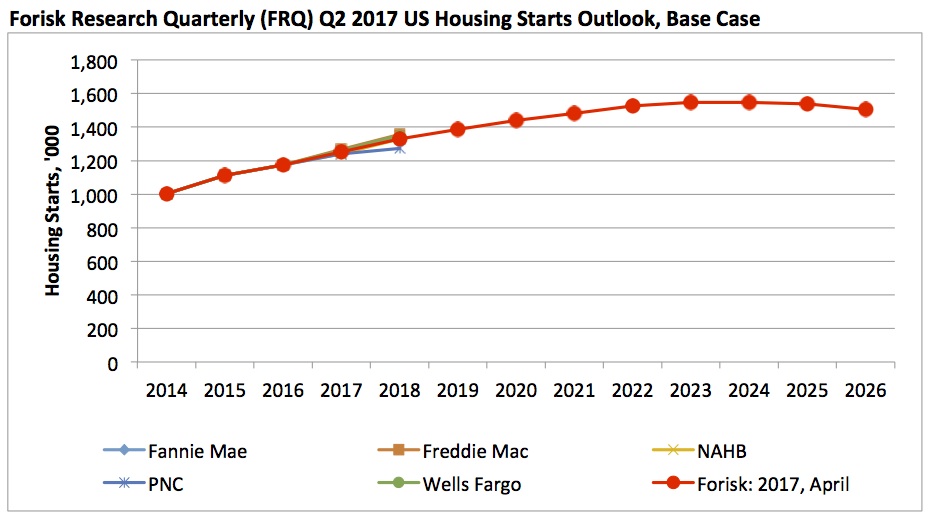This is the first in a series related to Forisk’s Q2 2017 forest industry analysis and timber price forecasts for the United States and Canada.
In our work, we apply forward-looking scenarios to our understanding of the “facts on the ground” to assess specific capital investments and local markets related to timberland, forestry and wood-using facilities. The models we build rely on assessments of how local timber markets and wood baskets perform given these macroeconomic scenarios. The scenarios and key assumptions have as much to do with the decision to be made as with the data available, and our understanding of the forces at work.
Each quarter, when updating models for the Forisk Research Quarterly (FRQ), we revisit prior projections and review applied research on business and economic forecasting. Forisk’s Housing Starts Outlook combines independent forecasts from professionals in the housing industry. Currently, these include Fannie Mae, Freddie Mac, the National Association of Home Builders (NAHB), PNC, and Wells Fargo. Forisk applies long-term assumptions from the U.S. Energy Information Administration (EIA) and Harvard’s Joint Center for Housing Studies to establish the peak and trend over the next ten years (Figure).

Overall, Forisk projects 2017 housing starts of 1.25 million, up 6.6% from 2016 actuals. This remains in line from our Q1 estimate. Forisk’s 2017 Base Case peaks at 1.55 million housing starts in 2023 before returning to a long-term trend approaching 1.50 million. For comparison, our January 2017 Base Case last quarter peaked at 1.54 million housing starts in 2023. The independent housing forecasts captured in Forisk’s Housing Starts Outlook reflect a range of expectations for 2017 that have merged since January. For example, Fannie Mae reduced its 2017 forecast from 1.31 million to 1.25 million, while PNC elevated its forecast from 1.20 million to 1.24 million starts for 2017.
In addition to the Base Case, Forisk applies a “Slow” Case scenario in the FRQ models to test the implications of less growth and lower levels of housing starts on forest industry production, investments and timber prices. The Slow Case assumes annual housing starts change at 50% of the Base Case. This results in 1.21 million starts for 2017. Overall, the Slow Case projects, on average over the next ten years, 10% fewer starts than the Base Case.
Forisk analyst Andrew Copley supported the research for this post. To learn more about the Forisk Research Quarterly (FRQ), click here or call Forisk at 770.725.8447.

Leave a Reply